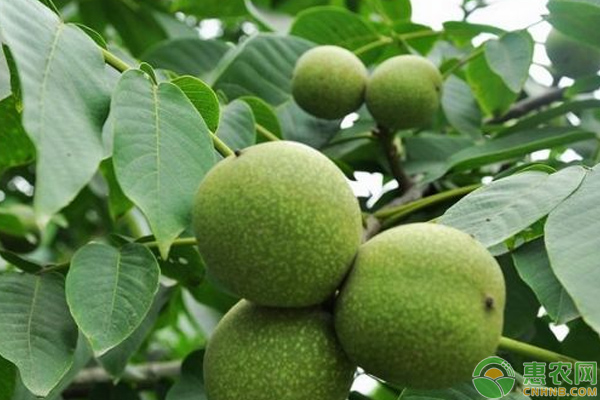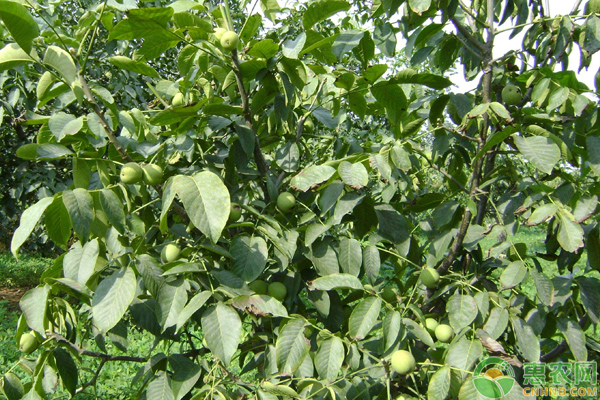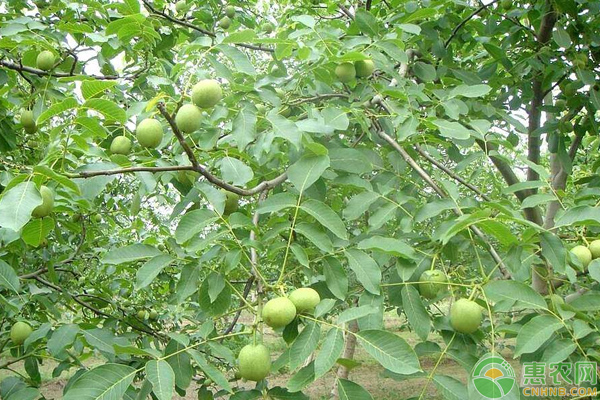Discussion on the occurrence regularity and control measures of walnut diseases and insect pests
Walnut is a "golden" nut, its nutritional value is high, long-term consumption can be very beneficial to the human body. At present, it is widely cultivated in China, and it is a good economic crop. The following small series will tell you in detail about the common pests of walnut disease. The law occurs. I hope to help the parents who plant walnuts.

1 The main law of pests and diseases
1.1 Walnut black spot
The pathogen of walnut black spot disease is Xanthomonas, which is an obligate parasitic species and can only infect walnut species. The optimum temperature for growth is 26.7 to 32.2 ° C, the highest critical temperature is 37.2 ° C, and the lowest critical temperature is 1.1 ° C. The pathogens lose their viability after exposure to sunlight for 30 to 45 minutes, and survive for 10 to 13 days under dry conditions, and survive for more than one year in the shoot ulcer tissue.
Walnut black spot is a bacterial disease, mainly harmful to young fruit and leaves, but also harmful shoots and inflorescences. After the walnut fruit is damaged, there are dark brown spots on the fruit surface, no obvious edges, and then gradually expand into a nearly round or irregularly shaped black spot, and sag, with a water-stained halo on the periphery and the fruit from the outward direction. It rots inside. After the leaves are damaged, first, black spots appear at the veins of the veins and veins, and then gradually enlarge into nearly round or polygonal dark brown lesions, the size is 3 to 5 mm, and the outer edge has a translucent halo. The back of the blade is oily and shiny. In severe cases, the plaques are enlarged, causing the leaves to be incomplete and fall off early. Cause dryness or dry chapped symptoms.
The pathogenic bacteria overwinter on the old lesions of susceptible branches, buds or stems. Hunchun spreads through rain, wind, insects and other activities, first making the leaves susceptible to disease, and then spreading the leaves to the fruit and branches. Walnut black spot disease begins in early May and early June, and continues to infect multiple times from late July to early August. The occurrence and severity of black spot disease of walnuts are closely related to temperature and humidity, and the incidence is early and severe in rainy years. The most susceptible period of walnut is the leaf-to-flowering period. When the tissue is young, the stomata is fully open, the wound is large, and the surface is wet, the pathogen is invaded. Under sufficient humidity conditions, the leaves can be infested at 4 to 30 °C. The fruit can be infested at 5 to 27 °C.

1.2 Walnut blight
The pathogen of walnut blight is a black rot fungus, belonging to the genus Hymenoptera. It is mainly harmful to young shoots, but also to fruits and leaves. The disease occurs in the walnut producing areas of the city. From the occurrence, the severity of the occurrence is different. The incidence is the most serious in Qingshui County and Zhangchuan County, and the disease rate is 23.6%. ~30.8%, the disease index is 17.8-27.5; the incidence of the river basin and the Weihe River is relatively light, the disease rate is 4.1% to 17.2%, and the disease index is 2.7 to 13.5. If there is a lot of rainfall in summer and autumn last year, and the climate is cold and windy in winter and spring, the degree of disease is heavy; on the contrary, the incidence is light. When the density of the walnut garden is large, the canopy is closed, and the ventilation and light transmission are poor, it is beneficial to the infection of the pathogen and the incidence is heavy; when the density is small, the incidence is light. The disease is infested from March to April in the spring, and the onset of the disease begins in May-June. The initial lesions are not obvious. As the lesions continue to expand, the cortex is dead and cracked. The conidial discs on the surface of the disease are constantly spreading conidia. Multiple infestation was carried out, and the onset of the disease occurred from July to August, and the disease was stopped after September. Qingxiang, Yuanlin, Wen 185, Jinlong No. 1 and other varieties are highly resistant to walnut shoot disease.
1.3 walnut limb moth
The genus Lepidoptera is a pest that seriously damages the leaves and fruits of young walnut trees. The walnut moths occur in the Tianshui area for one generation in one year. The old larvae are overwintered in the 1.5~3 cm deep soil layer under the tree, and they can also be wintered under weeds, tiles, stone seams and grass. A few wintering in the bark of the base of the old trunk. In the middle of June, the wintering larvae of the larvae in the middle of the year, about 7 days in the flood season; in the middle of June, the adults began to emerge; in the middle to late June to the beginning of July, the adult wintering period was over, and the adults were nocturnal, and the eggs were scattered. At the gap between the two fruits, a few are produced in the stalks and scorpions; from mid-June to mid-July, the incubation period is also the peak period of larvae, which is the key period for the prevention and control of canopy spraying. The newly hatched larva crawls on the fruit surface, and then enters the fruit and stalks from the back surface, and the larvae in the affected fruit are 5 to 6 heads. The feces are discharged in it, and transparent or amber water droplets flow out from the pupil. 30 to 45 days old larvae mature, fruit removal into the soil for the winter, fruit removal period from late July to late August, fruit removal period in early August. The larvae gradually turn amber after the capsules, and finally turn black, so it is called "walnut black."

1.4 Walnut Fruit Elephant
Walnut fruit is a species of Coleoptera, which is mainly a larvae that damages the fruit of walnuts. Adults feed on young shoots and shoots. According to the field tree survey, when the walnut tree began to sprout, the walnut fruit weevil began to separate from the tree. The first thing was to eat the young and young leaves. In June, the adult larvae increased greatly. After hatching, the larvae are harmful in the fruit and discharge brown feces and juice to the outside, causing a large number of fruit drop. From the time of spawning to fruit drop, it usually takes about 20 days, and from late June to mid-July, it is the fruit drop period.
1.5 walnut leaf miner
The genus Lepidoptera is a genus of the genus Lepidoptera, which is a severely damaged eucalyptus. Adults lay eggs on the edge of young shoots or veins. The larvae sneak into the front of the leaves. They mainly feed on the mesophyll of walnuts. They do not feed forward in the larvae during the overeating period, and form the flakes and flesh in the leaves. It is black granules and is concentrated on one side of the worm. On the other hand, the larvae of the walnut leaf miner can wear the midrib of the leaf when feeding, and the leaves of the feeding place only leave the upper epidermis, which causes the surface layer of the leaf to detach from the leaf, which causes the damaged part of the leaf to curl, dry and yellow. . When the damage is serious, a number of leaf miner larvae feed on one leaf at the same time, and 60% of the leaf flesh is fed, causing the leaves to dry and fall off. July-August is the period of the larvae of the walnut leaf miner, which is also the most serious period.
2 Integrated pest control techniques for walnuts
The prevention and control of walnut pests and diseases should be based on the principle of “prevention first, comprehensive prevention and controlâ€, with agricultural control and physical control as the mainstay, with little or no chemical control. The selection of pesticides is also based on high efficiency, low toxicity and low residue, minimizing the number of spraying and reducing pollution.
2.1 Agricultural control
In the production, the scientific management of walnut trees should be strengthened, such as plastic trimming, formula fertilization, fertilizer pipe protection, cultivating and weeding, etc., in order to enhance the tree potential and improve the disease resistance of the tree.
Cut off the pests and diseases of the pests and diseases. At the end of September, after the walnuts are harvested, the branches and pests should be cut off or buried in the ground on the basis of plastic pruning. In the spring or autumn, the shaving tree disc destroys the normal living environment of the walnut moth and the walnut fruit, and it can not be feathered and reduce the density of the insects in the coming year.
Picking up the fruit and removing the pests and diseases, the larvae of the pests such as walnuts, moths and walnuts are harmful to the fruit. After the fruit is damaged, the fruit can be caused to fall. The larvae continue to harm in the fallen fruit and become phlegm in the damaged fruit. . To this end, in the middle of June each year, the insects, black fruit and the fruit on the surrounding ground should be cleaned up, and concentrated with 50% malathion EC 800 times, which can effectively reduce the next year. The number of insects.
2.2 Chemical control
According to the species and hazard characteristics of walnut pests and diseases, spray 1 or 2 times 72% agricultural streptomycin WP 1500 times or 20% leaf cumin WP 500 times, 3 times per year from the end of April to the middle and late May. % bacteriocin wettable powder 800 times solution, 20% copper acetate wettable powder 1600 times solution and the like. Spraying 2 or 3 times of the drug after mid-June, you can choose to spray 60% Mn-Zn-myrazole WP 1000 times solution or 70% enoyl sulphate water-dissolving granules 1200 times solution, 80% Haiyin WP 1000 times solution +72% agricultural streptomycin WP 1500 times solution or 20% leaf carbazole WP 500 times solution, 3% carbendazim wettable powder 800 times solution, 20% acetic acid Copper wettable powder 1600 times liquid + 20% high chlorine · horse emulsifiable oil 1200 times liquid or 20% cyanopentan marathon 1200 times liquid, 48% chlorpyrifos 1200 times liquid and other agents, can effectively prevent walnut black spot, walnut dry Diseases and pests such as tip disease, walnut limb moth, walnut fruit weevil, and walnut leaf miner.
Walnut is one of the four nuts, which is popular among people in daily life. It often causes diseases during planting. The main ones are black spot, blight, and leaf miner. If the disease release is not timely, it will seriously affect the growth of walnuts, so you must strengthen the field management. The above is the detailed occurrence of walnut pests and diseases and prevention measures, you can refer to.
Colored adhesive bandage
Wenzhou Celecare Medical Instruments Co.,Ltd , https://www.wzcelecare.com